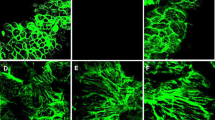Abstract
A specific human fetal heart RNA has been discovered, which has the ability to induce myocardial cell formation from mouse embryonic and human-induced pluripotent stem cells in culture. In this study, commercially obtained RNA from human fetal heart was cloned, sequenced, and synthesized using standard laboratory approaches. Molecular analyses of the specific fetal cardiac-inducing RNA (CIR), revealed that it is a fragment of N-sulfoglucosaminesulfohydrolase and the caspase recruitment domain family member 14 precursor. Stem cells transfected with CIRs often form into spindle-shaped cells characteristic of cardiomyocytes,and express the cardiac-specific contractile protein marker, troponin-T, in addition to tropomyosin and α-actinin as detected by immunohistochemical staining. Expression of these contractile proteins showed organization into sarcomeric myofibrils characteristic of striated cardiac muscle cells. Computer analyses of the RNA secondary structures of the active CIR show significant similarities to a RNA from salamander or myofibril-inducing RNA (MIR), which also promotes non-muscle cells to differentiate into cardiac muscle. Thus, these two RNAs, salamander MIR and the newly discovered human-cloned CIR reported here, appear to have evolutionarily conserved secondary structures suggesting that both play major roles in vertebrate heart development and, particularly, in the differentiation of cardiomyocytes from non-muscle cells during development.









Similar content being viewed by others
References
Bertin J, Wang L, Guo Y, Jacobson MD, Poyet JL, Srinivasula SM, Merriam S, DiStefano S, Alnemri ES (2001) CARD11 and CARD14 are novel caspase recruitment domain (CARD)/membrane-associated guanylate kinase (MAGUK) family members that interact with BCL10 and activate NF-kappa B. J Biol Chem 276(15):11877–82
Kochegarov A, Moses A, Lian W, Hanna MC, Lemanski LF (2013) A new unique form of microRNA from human heart, microRNA-499c, promotes myofibril formation and rescues cardiac development in mutant axolotl embryos. J Biomed Sci 20(1):20
Lemanski LF, Nakatsugawa M, Bhatia R, Erginel-Unaltuna N, Spinner B, Dube DK (1996) A specific synthetic RNA promotes cardiac myofibrillogenesis in the Mexican axolotl. Biochem Biophys Res Com 229:974–981
Lemanski LF, Zhang C (2007) Promoting cardiac cell differentiation (US Issued Patent [9/18/07] 60/462 171).
Lemanski LF, Zhang C, Kochegarov A, Moses A, Lian W, Meyer J, Jia P, Jia Y, Webster KA, Huang X, Hanna M, Achary MP, Lemanski SL, Weissbach H (2012) Protection of mouse embryonic stem cells from oxidative stress by methionine sulfoxide reductases. In: Lushchak VI, Semchyshyn HM (eds) Oxidative stress: molecular mechanisms and biological effects. InTech, Rijeka, pp 197–230
Moses-Arms A, Kochegarov A, Arms J, Burlbaw S, Lian W, Meyer J, Lemanski LF (2014) Identification of a human mitochondrial RNA that promotes tropomyosin synthesis and myocardial differentiation. In Vitro Cell Dev Biol. Animal doi:10.1007/s11626-014-9834-2
Mummery C, Ward D, van den Brink CE, Bird SD, Doevendans PA, Opthof T, Brutel de la Riviere A, Tertoolen L, van der Heyden M, Pera M (2002) Cardiomyocyte differentiation of mouse and human embryonic stem cells. J Anat 200(Pt 3):233–242
Rueda-de-León E, Kochegarov A, Lian W, Athauda G, Zhang C, Maier J, Huang X, Achary MP, Moses A, Meyer J, Arms JD, Burlbaw SR, Lemanski SL, Lemanski LF (2011) Human heart RNA promotes tropomyosin synthesis and myofibrillogenesis in mutant axolotl hearts. MD-Med Data 3:223–227
Sehnert AJ, Huq A, Weinstein BM, Walker C, Fishman M, Stainier DY (2002) Cardiac troponin T is essential in sarcomere assembly and cardiac contractility. Nat Genet 31:106–110
Sferrazza GF, Zhang C, Jia P, Lemanski SL, Athauda G, Stassi A, Halager K, Maier JA, Rueda-de-Leon E, Gupta A, Dube S, Huang X, Prentice HM, Dube DK, Lemanski LF (2007) Role of myofibril-inducing RNA in cardiac TnT expression in developing Mexican axolotl. Biochem Biophys Res Com 357:32–37
Zajdel RW, Thurston H, Prayaga S, Dube S, Poiesz BJ, Dube DK (2007) A reduction of tropomyosin limits development of sarcomeric structures in cardiac mutant hearts of the Mexican axolotl. Cardiovasc Toxicol 7:235–246
Zhang C, Dube D, Huang X, Zajdel RW, Bhatia R, Foster D, Lemanski SL, Lemanski LF (2003) A point mutation in bioactive RNA results in RNA secondary structure alteration and failure of mutant heart correction in Mexican axolotls. Anat Embryol 206:495–506
Zhang C, Jia P, Huang X, Sferrazza GF, Athauda G, Achary MP, Wang J, Lemanski SL, Dube DK, Lemanski LF (2009) Myofibril-inducing RNA (MIR) is essential for tropomyosin expression and myofibrillogenesis in axolotl hearts. J Biomed Sci. doi:10.1186/1423-0127-16-81
Zhang C, Pietras KM, Sferrazza GF, Jia P, Athauda G, Rueda-de-Leon E, Maier JA, Dube DK, Lemanski SL, Lemanski LF (2007) Molecular and immunohistochemical analyses of cardiac troponin T gene during the cardiac development of Mexican axolotls, Ambystoma mexicanum. J Cell Biochem 100:1–15
Acknowledgments
This work is supported by an NIH grant (HL061246), NSF grant (1121151), and an American Heart Association grant (10GRNT4530001) awarded to LFL. The authors are grateful to Rosalia Ogunpeju, Barbara Williams, Mallory Dennie, and Sharon Lemanski for excellent secretarial support in preparing the manuscript.
Author information
Authors and Affiliations
Corresponding author
Additional information
Editor: T. Okamoto
Rights and permissions
About this article
Cite this article
Kochegarov, A., Moses-Arms, A. & Lemanski, L.F. A fetal human heart cardiac-inducing RNA (CIR) promotes the differentiation of stem cells into cardiomyocytes. In Vitro Cell.Dev.Biol.-Animal 51, 739–748 (2015). https://doi.org/10.1007/s11626-015-9880-4
Received:
Accepted:
Published:
Issue Date:
DOI: https://doi.org/10.1007/s11626-015-9880-4




